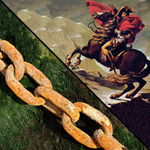 We all know sugar is bad for us and our teeth. But sugar has also proven to be bad for civilization in many ways.
We all know sugar is bad for us and our teeth. But sugar has also proven to be bad for civilization in many ways.
Sugar was known in India for thousands of years, where sugar cane was a native plant. It was also known, and grown in China over 2,000 years ago. The Romans knew about it, and Pliny the Elder described it as ‘used for medicinal purposes only”.
Crusaders brought it back to Europe early in the 12th century where it was welcomed as an alternative to honey. By the 15th century Venice was the chief sugar refining and distribution center in Europe and it grew into a passion for all things sugar throughout Europe.
Columbus took sugar cane from the Canary Islands (off the coast of Spain) to the New World, resulting in the first sugar cane harvest in 1501. Within 20 years, there were sugar plantations and mills in Cuba and Jamaica. The Portuguese had begun planting it in Brazil. By 1550 there were about 3,000 sugar mills in the Caribbean and South America. By the late 1700s the British and French colonies in the Caribbean produced 80% of the sugar imported into Europe.
The only problem with producing sugar and running sugar cane plantations was that it was very labor intensive to produce. Labor was in short supply. This demand for cheap labor brought a boom in the slave trade to the Caribbean, the so called ‘triangle trade’. A ship would pick up slaves in Africa and sell them in the Caribbean. From there they would buy sugar to sell in the United States or Europe where sugar was still a luxury and brought high prices. The profits from sugar allowed them to buy more slaves – and so it continued for over 300 years.
Interestingly, several European governments and the Pope all banned the enslavement of Native Americans beginning in the 16th century. The only exception was if they were cannibals. This had the effect of encouraging the importation of African slaves to North and South America.
Because sugar was expensive, it was primarily eaten by the wealthy, who, in America might very well have been slave owners themselves.
People like George Washington and Thomas Jefferson.
During that time, there was no such thing as modern, restorative dentistry. If you had a bad tooth, the only solution was to pull it. Ironically, many of the wealthiest people, including royalty, suffered horrible dental problems from their love affair with all things sweet. This left many people at all levels of society with not only bad teeth, but often, very few teeth. Washington had only one natural tooth left when he was sworn in as the first President of the United States.
The solution? Dentures. They were uncomfortable, distorted the face, couldn’t be used for chewing and even made speaking difficult. The denture base was most often made of carved ivory or bone and sometimes lead. The teeth mounted in them were often from horses or donkeys or carved ivory or bone. Some had human teeth, but those were difficult to get (coming mostly from ‘resurrectionists’ who dug up corpses to ‘harvest’ the teeth and anything else they thought might be saleable).
As with sugar, dentures were expensive and only the wealthy could afford them. That is until Napoleon came along and went to war with most of Europe. His final defeat at the Battle of Waterloo (which is located in Belgium) resulted in the deaths of over 41,000 men in one day in June 18,1815.
There was always demand for real human teeth and suddenly there was a huge supply. The soldiers, who were largely young, healthy males, were likely to have good teeth. There were multiple field hospitals and aid stations around the battlefield giving surgeons and aid workers a chance to collect teeth from the dead soldiers. Since the soldiers were buried in mass graves (there were no bones found on the actual battlefield), it made it easier to collect the teeth through the health care facilities. There are also stories of enterprising locals collecting teeth before the corpses were collected from the battlefield and buried.
These “Waterloo teeth” as they came to be called, were then shipped to England and other parts of Europe by the barrel. For dentists and others who made dentures, this was a bonanza. They could now make dentures with real, human teeth that almost anyone could afford.
Unfortunately, the American Civil War (1861-1865), also provided an abundance of teeth from the soldiers who died during the war. These were again collected and shipped to England and the rest of Europe for use in the making of dentures.
Then, with the Industrial Revolution, things began to change rapidly. Machines made sugar less labor intensive. Slavery was (officially) abolished through the Caribbean in 1804 and the US in 1865. Cuba was the lone exception. Slavery wasn’t abolished there until 1898. Perhaps because American sugar interests controlled 2/3 of Cuban sugar?
The Civil War brought the beginnings of modern, restorative dentistry. During that time, more comfortable materials for denture bases were developed, as well as porcelain for denture “teeth”.
And we still eat WAY too much sugar…
…and dentures are becoming more popular – again – as an ‘alternative to no teeth’.
Are we learning anything from history repeating itself?
https://www.sugar.org/sugar/history/
https://www.alcademics.com/2011/09/sugar-in-early-american-history.html
http://www.sugarhistory.net/who-made-sugar/history-of-sugar/
http://www.historyhome.co.uk/c-eight/france/teeth.htm
https://bda.org/museum/collections/teeth-and-dentures/waterloo-teeth
